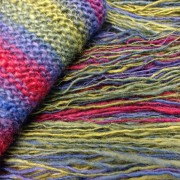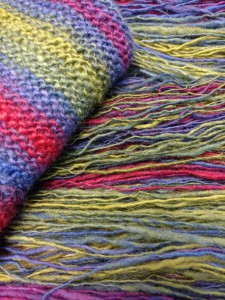Learning to Love the Singles yarn
Guest blogger Amberlee Venters visits us today with her story of learning to spin outside her own box and give singles yarn a try, both for spinning and knitting. If you’ve ever been hesitant to spin a singles yarn, Amberlee’s story might just inspire you to try an experiment of your own.
——————————————————————————————————–
The Inspiration
In my spinning room (if you understand “room” to mean “bin in a closet in a room,”) I have a bunch of 4-oz braids of gorgeous, multicolored roving, which is mostly the result of several years in a fiber club that I never could quite stay on top of. These braids, bags, and bumps sit there, nestled in amongst their brethren, waiting for the day that they will reach their full potential.
I have only knit with singles yarns a few times, and during those experiments I learned of my tendency to remove twist from the yarn as I knit – a super-helpful technique for creating a finished object without a million ends to weave in. This, along with the multitudes of plied yarn available to me, has been enough to generally put me off spinning singles.
As I rarely knit with singles I also don’t tend to spin singles that will remain singles. My goal since learning to spin has been to achieve the coveted sock yarn, consequently I almost always approach my spinning with fingering weight in mind. So the idea of spinning something new, along with the motivation that this new method might result in going from braid to yarn in a shorter period of time, led me to give singles another try.
The Experiment
I sat down with a 4-oz braid of Falkland wool, zero expectations, and no plan. I debated with myself the best way to spin this fiber: Do I go with my default fingering weight? Or, more accurately: Will I be able to achieve anything else at this point? Maybe I should try to aim for something thicker. This is a singles yarn after all, it’s staying a singles yarn. And anyway what if I hate it? Better to have less yarn if I hate it.
As I discovered, spinning singles yarns goes refreshingly quickly! Within a few days I filled the bobbin and exhausted t he fiber. Success! I had made a single that would stay a single, and with no plying to do I was practically done! The next challenge would be winding the yarn off the bobbin. (See above comment re: I accidentally untwist everything I knit.) To my complete surprise I was able to wind the yarn from the bobbin easily and with no breaks. More Success! Perhaps it would even make it through its bath in one piece! Maybe I’d even manage to not felt it into a huge mess! I eagerly drew a tub of water and deposited the fiber within. What emerged some time later (I tend to forget when I put things in to soak. Surely I’m not the only one? No? Just me? Cool) was the most uneven mass of yarn I had created in years. When I first learned to spin I read that once you attain the thin, beautiful, even sock yarn of your dreams it is nigh impossible to spin anything other than fingering weight without extreme concentration and clarity of intent. Since I went in to this with neither of those qualities, I expected the worst. This yarn came out completely uneven and crazy, but also squishier and softer than anything else I’d managed to create thus far. So maybe it wasn’t a failed experiment after all!
he fiber. Success! I had made a single that would stay a single, and with no plying to do I was practically done! The next challenge would be winding the yarn off the bobbin. (See above comment re: I accidentally untwist everything I knit.) To my complete surprise I was able to wind the yarn from the bobbin easily and with no breaks. More Success! Perhaps it would even make it through its bath in one piece! Maybe I’d even manage to not felt it into a huge mess! I eagerly drew a tub of water and deposited the fiber within. What emerged some time later (I tend to forget when I put things in to soak. Surely I’m not the only one? No? Just me? Cool) was the most uneven mass of yarn I had created in years. When I first learned to spin I read that once you attain the thin, beautiful, even sock yarn of your dreams it is nigh impossible to spin anything other than fingering weight without extreme concentration and clarity of intent. Since I went in to this with neither of those qualities, I expected the worst. This yarn came out completely uneven and crazy, but also squishier and softer than anything else I’d managed to create thus far. So maybe it wasn’t a failed experiment after all!
Now the real test – could I knit with this yarn without untwisting it and ruining the project? I settled on a simple cowl pattern – the Variance Cowl by Lisa Mutch – a quick knit in case thing went hilariously awry. As it turns out this was a good choice, because I did indeed untwist the yarn while I was knitting. Twice. However, I ended up with a very lightweight, squishy, soft cowl. Lighter than anything I’ve made before, despite its lack of lace and abundance of wacky inconsistencies. This is a revelation! (This wacky hobby of mine is a bit silly out here in California, you see. Making lighter weight items is key to enjoying knitted things for more than a month or two each year.)
The Results
Confronting my hatred of singles has taught me a few things:
- Spinning for singles yarn is speedy compared to the slow spin of sock yarn. This is great news, especially when faced with a seemingly unending bin of 4-oz braids from fiber clubs.
- I have to watch my twist, particularly because of my knitting problem. If I had been more fastidious regarding the amount of twist added I probably would have encountered less untwisting in the knitting process.
- Not spinning fingering weight yarn is really tricky! I still ended up with a finished yarn that’s somewhere in the range of heavy fingering to sport weight most of the time.
Going into this experience I fully intended to continue disliking singles yarns, but this is not the case at all. I’m sure I’ll experiment more with spinning singles yarns for the sake of singles in the future, but I definitely need to plan my attack more completely (if you understand “completely” to mean “at all”).
Amberlee exists on Ravelry under the slightly embarrassing username: amberleesapain. She currently has no blog but is considering starting one.







Have you tried spinning your singles the opposite way, to see if it helps with the knitting? I’ve found that my z-spun singles fall apart when I knit with the yarn, but if I make s-spun singles instead it works much better.
I agree with Eliza; also I believe crochet tends to untwist the opposite way!
You are meant to spin singles anti clockwise. Hope that helps